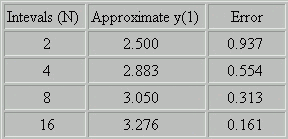Most ordinary differential equations arising in real-world
applications cannot be
solved exactly. These ode can be
analyzed qualitatively. However,
qualitative
analysis cannot
give accurate answers. A numerical method can be used
to get
an accurate approximate solution to a differential
equation. There are many
programs and packages for solving
differential equations. With today's
computers, an accurate
solution can be obtained rapidly. In this section we
focus
on Euler's method, a basic numerical method for solving
differential
equations.
We illustrate Euler's method by considering the differential equation:
![]()
This is an example of linear ode and can be solved exactly; the answer is
![]()
Suppose our goal is to compute the solution at t=1. We will
do this using two steps
of size 0.5. Our goal is to approximate
the solution at t_1=0.5 and t_2=1. Let us call
denote v_i to
be the approximate solution at t_i. We let 0=t_0 and
y(0)=1=v_0.
We proceed by first determining v_1. According to the differential
equation, the
slope at t_0 is y'=f(t_0,v_0). If we assume that
the slope is constant between
t_0 and t_1, then we get the
following approximation for v_1
![]()
where h=t_1-t_0 is the stepsize. For the model problem we have
![]()
The figure below shows how the approximation compares to the
exact solution.
Remember, v_1 is obtained by assuming that
the initial slope f(t_0,v_0) is
constant in the time interval.
Since the slope of the exact solution
f(t,y)=t+y
is increasing as t increases, our approximation
v_1=1.5 is less than the exact
answer y(t_1)=1.8.

We
compute
v_2 using information at t_1.
![]()
Here h=t_2-t_1. The exact answer is y(1)=3.44.
We can write down a general formula for Euler's method. Suppose that the goal is to solve the ode
![]()
and to determine y(T).
![]()
to compute approximate solutions for k=0,1,2, ...
A fundamental question at this point is: Does Euler's method
work? Does the
approximate solution approach the exact solution
as the number discretization
points increases? The answer is
yes. The following table lists the approximate
answer at t=1
if N equispaced intervals are used. The exact solution is y(1)=3.44.

As we see, the error decreases as N increases. Note that error
is approximately cut
in half when N is doubled. Euler's method has order
of accuracy 1. A method has
order of accuracy p if
![]()
There many other numerical methods for computing approximate solutions
to
differential equations. Some methods use information at several time
steps to
compute a new approximation at t_k+1 (multistep methods). Other
methods
compute v_k+1 from v_k in several stages (Runge-Kutta) methods.
[ODE Home] [1st-Order Home] [2nd-Order Home] [Laplace Transform Home] [Notation] [References]
Copyright © 1996 Department of Mathematics, Oregon State University
If you have questions or comments, don't hestitate to contact us.